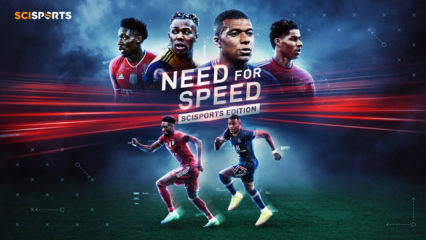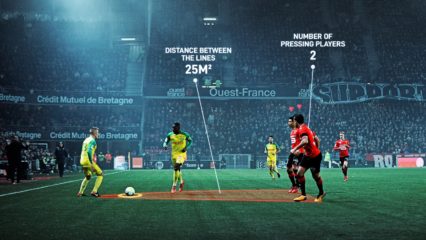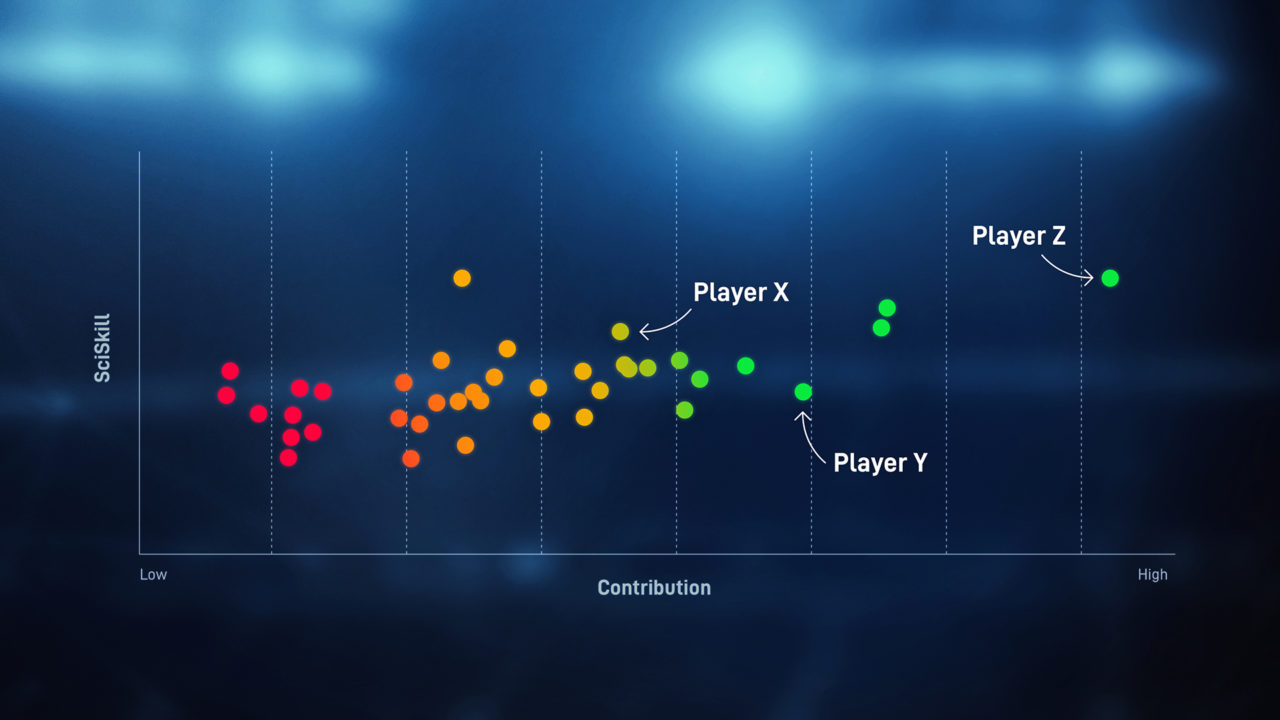
In the 2020 summer transfer window, Chelsea signed strikers Timo Werner and Hakim Ziyech from RB Leipzig and Ajax, respectively. With Timo Werner Chelsea bought a player that was one of the top strikers in the German Bundesliga, who was especially valuable to his team with his dribbles and close-distance shots. In contrast, Hakim Ziyech brings value to his team with his chance creation passes, long-distance shots, cut inside dribbles and early crosses. To analyze the performances of players such as Timo Werner and Hakim Ziyech, the SciSports Platform offers the Performance module to analyze a player’s contribution to the team on different types of actions such as long-distance shots, deep completion passes, early crosses and defensive headers. The Performance module is part of the Player Profile which enables you to quickly get a general overview of a player’s skill, development, style of play and performance which is very useful in the process of finding new players for your team.
An important task for football scouts is to assess how football players contribute to the performances of their teams. To assist scouts in this process, the Performance module quantifies the performances of players in many different areas, like a player’s performance on short passes, attacking headers, receptions in the final third, tackles and recoveries in the own third. While traditional football statistics such as the number of completed passes or number of successful tackles only consider how often a player performs a particular type of action, SciSports’ Contribution Ratings measure the contribution of different types of player actions by accounting for both their frequency and impact on the match. The Contribution Ratings, that are shown in the Performance module, assess the impact of each player’s actions on the course of a match. Intuitively, we measure how each player’s actions affected their team’s chances of scoring and conceding a goal.
The importance of considering an action’s impact is nicely illustrated by the following two video clips. The first clip shows a pass from Chelsea’s Hakim Ziyech to his teammate who heads the ball to Timo Werner leading to a Chelsea goal. The second clip shows a pass from Steven Bergwijn from a similar position to his teammate on the flank.
While both passes go down the books as a successfully completed pass, Ziyech’s pass into the box clearly had a bigger influence on the course of the match than Steven Bergwijn’s pass to the flank. Our Contribution Ratings are able to identify that Ziyech’s pass increases his team’s chances to score more than Bergwijn’s pass does. Therefore, Ziyech’s pass will be valued higher than Bergwijn’s pass.
How are the Contribution Ratings calculated?
The Contribution Ratings assesses the impact of each player’s actions on the course of a match. Intuitively, these metrics measure how each player’s actions affected their team’s chances of scoring and conceding a goal. The higher the Contribution Rating for a particular type of action is, the more the player has contributed to increasing the chances of scoring a goal or decreasing the chances of conceding a goal by performing that type of action. Actions that yield more favorable match situations receive positive values, whereas actions that yield less favorable match situations receive negative values. For example, Ziyech’s pass increased the team’s chances of scoring a goal, as he received the ball in a not so promising position, but managed to get the ball to a teammate in a very promising position.
The Performance module shows the average contribution per match in a season. For every player, Contribution Ratings of all individual actions of a certain action type are summed up and normalised for the minutes he has played (per season). When we consider action type Long-distance shots, for example, we obtain the contribution for a player by first summing the Contribution Ratings of his/her long-distance shots in the season and then normalizing the obtained sum per 90 minutes of play. In this way, we observe that Hakim Ziyech’s long-distance shots in the complete 2018/2019 Eredivisie season yielded more value per 90 minutes of play than Steven Bergwijn’s long-distance shots.
SciSports’ Performance module provides insights on a player’s contribution to the team
SciSports’ Performance module directly provides insights in the strengths and weaknesses of a player compared to players playing in the same position in the same league. For example, Figure 1 shows that Hakim Ziyech ranks among the highest performing wingers in the 2019/2020 Dutch Eredivisie season. He mainly has impact with his middle long passes (between 10 and 34 meters), chance creation passes (passes sent from the final third) and direct passes. On the other hand, he executes risky actions and has low performance with playing safe in the opponent half.
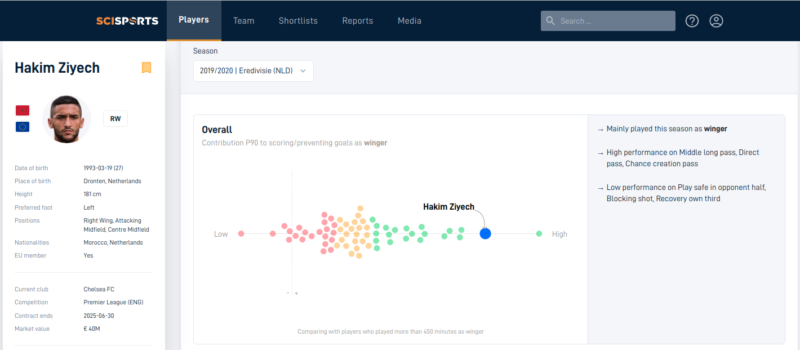 Figure 1. Hakim Ziyech ranks among the highest performing wingers in the 2019/2020 Eredivisie season
Figure 1. Hakim Ziyech ranks among the highest performing wingers in the 2019/2020 Eredivisie season
The Performance module enables the user to analyze the performance of a player on 10 different types of action groups, 6 offensive action groups — Passing, Dribbling, Ball Retention, Crossing, Finishing and Offensive Positioning — and 4 defensive action groups — Defensive positioning, Preventing, Pressing and Recoveries. In this way, you have a perfect overview of the action types on which a player contributes a lot and with which he does not contribute much. It is also possible to compare players, Figure 2 shows that Steven Bergwijn has a different set of skills when compared to Hakim Ziyech. Steven Bergwijn mostly brings value to his team with his dribbles, whereas Hakim Ziyech is mostly important with his passes and crosses.
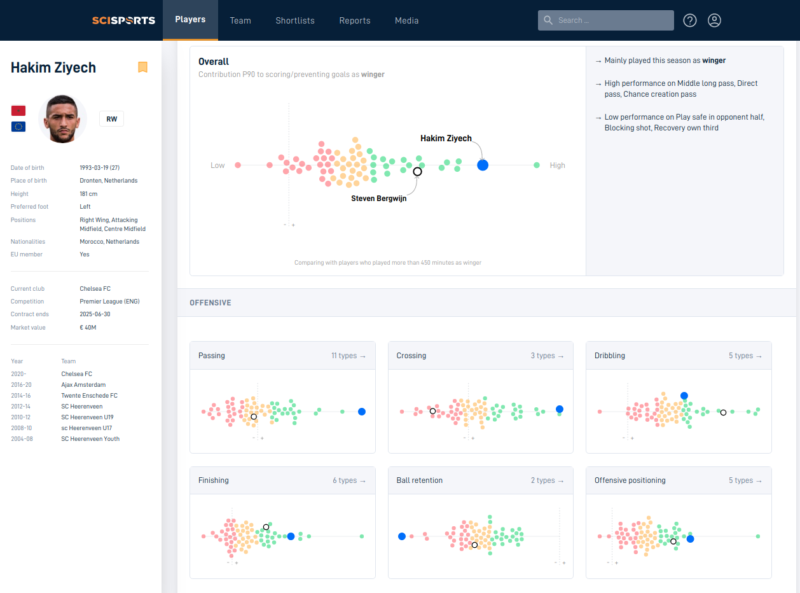 Figure 2. A comparison between Hakim Ziyech and Steven Bergwijn in terms of their performance in the 2019/2020 Eredivisie season
Figure 2. A comparison between Hakim Ziyech and Steven Bergwijn in terms of their performance in the 2019/2020 Eredivisie season
We observe that both players contribute similarly to their team with their finishing actions, but when we have a more-detailed look we see that they do this in a different way. Both players are clearly not valuable with their attacking headers and in finishing crosses. The difference between both is that Ziyech is especially strong with his long-distance shots whereas Bergwijn’s performance mostly comes from close shots from inside the box after a dribble or a pass from a team mate.
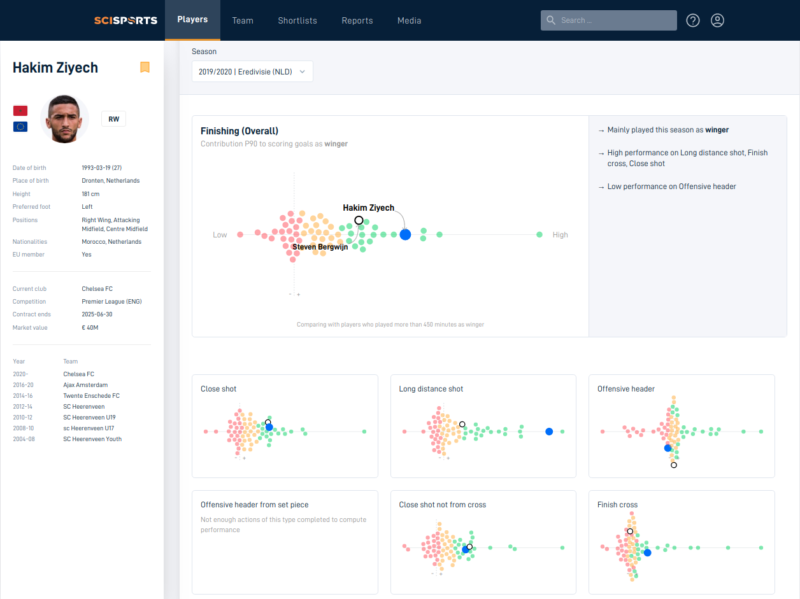 Figure 3. A comparison between Hakim Ziyech and Steven Bergwijn in terms of finishing performance. We observe that Ziyech is especially strong with his long-distance shots when compared to all wingers in the 2019/2020 Dutch Eredivisie. On all other action types Ziyech and Bergwijn show similar performance
Figure 3. A comparison between Hakim Ziyech and Steven Bergwijn in terms of finishing performance. We observe that Ziyech is especially strong with his long-distance shots when compared to all wingers in the 2019/2020 Dutch Eredivisie. On all other action types Ziyech and Bergwijn show similar performance
The detailed action types, there are 50 in total, enable you to search for the right players that tend to bring value to their team with the action types that are relevant for your club. One might look for a winger that can bring value to the team with dribbles cutting inside, switching play sideways and direct passes to the center forward, or one might look for a winger that can dribble past his opponent, finish close shots and is also valuable with his defensive duties. In the first example, a player like Hakim Ziyech would be your perfect fit, in the second example a player like Steven Bergwijn would be the player you are looking for.
Finding hidden gems
The SciSports Platform currently provides the Performance module for about 100 domestic competitions in more than 60 countries across the world. Our coverage ranges from the English Premier League to the Colombian Liga Águila to the Japanese J2 League (2nd tier) to the Dutch Tweede Divisie (3rd tier). The Performance metrics for the players in the covered competitions are updated within a few days after each match and a player’s performance is displayed in the SciSports Platform from the first minute he starts playing in a new season. On a player’s Player Profile, one can find the player’s performance for the matches where he played in the player’s most-used position that season. To obtain a reliable comparison, we compare the player with players in the same position in the same league that played at least 450 minutes in that season.
We decided to show a player’s performance directly when he starts playing such that our users can find hidden gems before anyone else does. When a player played a low number of minutes, his performance is not yet representative of his skill level, but it might help to quickly identify high performing young players. For example, Erling Haaland was a top performer in the 2016 Norwegian Obos Ligaen season just like Frenkie de Jong was in his first 159 minutes for Ajax’ first team in the 2016/2017 Eredivisie season. Figure 4 shows his performance in that season compared to midfielders who played at least 450 minutes in that season.
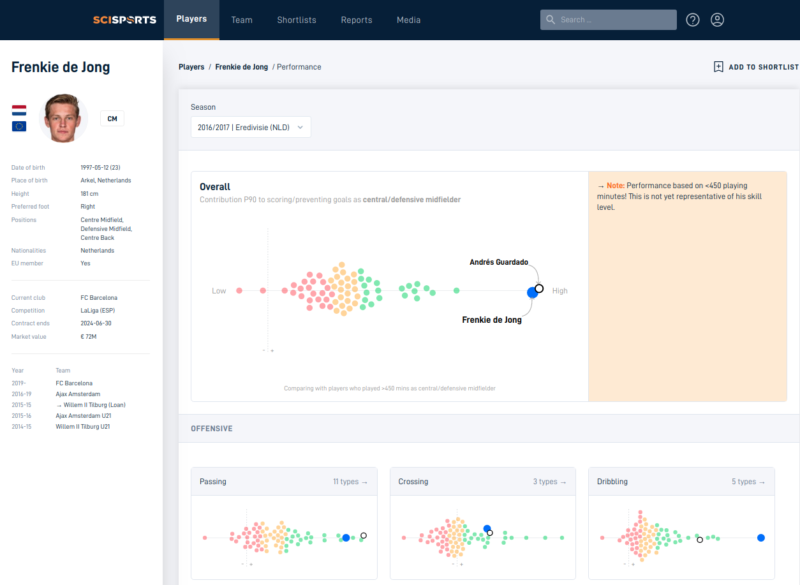 Figure 4. Frenkie de Jong’s performance in the 159 minutes he played for Ajax in the 2016/2017 Eredivisie season. He showed similar performance in those few minutes to PSV’s defensive midfielder Andrés Guardado
Figure 4. Frenkie de Jong’s performance in the 159 minutes he played for Ajax in the 2016/2017 Eredivisie season. He showed similar performance in those few minutes to PSV’s defensive midfielder Andrés Guardado
Everyone is looking for the new Erling Haaland or Frenkie de Jong and wants to find hidden gems before anyone else does. The SciSports Platform can be used to find those hidden gems. Using the Performance metrics, we can identify young players that show very high performance in their first matches. For example, two young players that show high performance in the ongoing 2021 season in the Scandinavian leagues are Williot Swedberg (Hammarby IF) and Emil Konradsen Ceide (Rosenborg BK). Figure 5 and 6 show their performances in the 2021 Allsvenskan and Eliteserien seasons respectively.
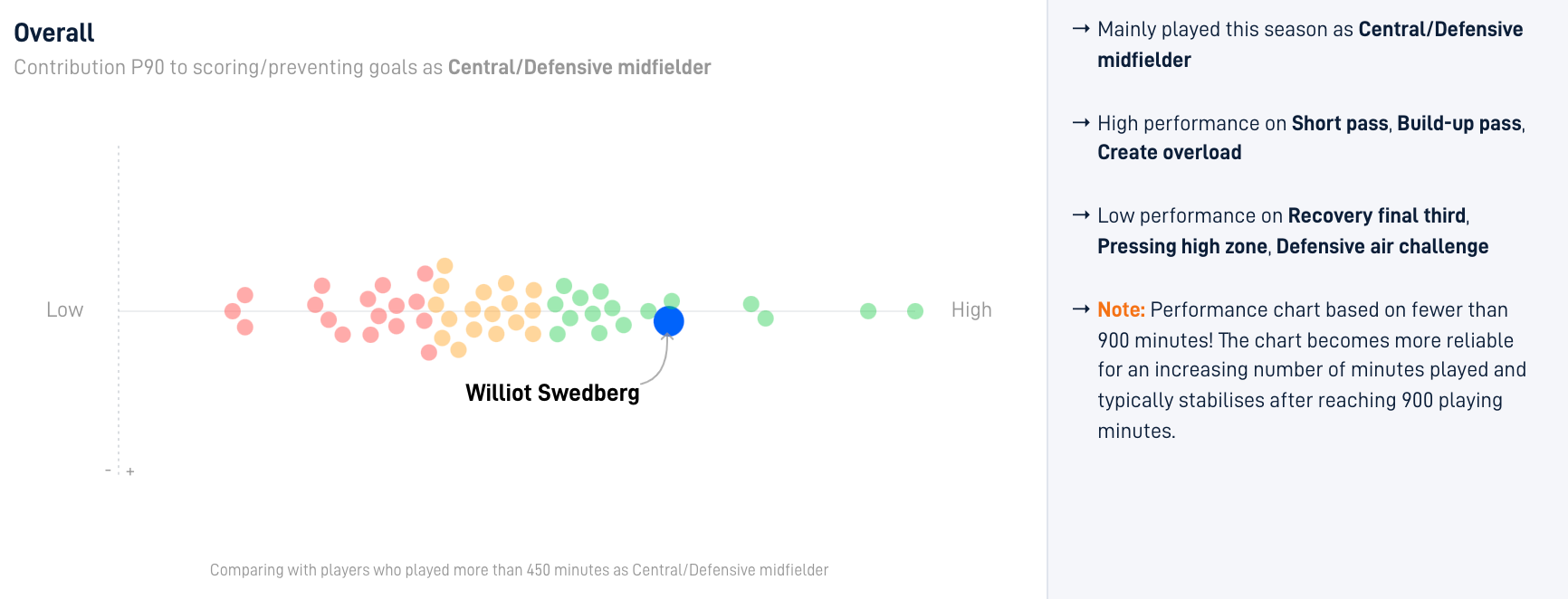 Figure 5. Williot Swedberg’s performance in the 2021 Allsvenskan season. He was one of the highest performers compared to all other central/defensive midfielders that played at least 450 minutes in the same season. He is especially strong with his passing and dribbling.
Figure 5. Williot Swedberg’s performance in the 2021 Allsvenskan season. He was one of the highest performers compared to all other central/defensive midfielders that played at least 450 minutes in the same season. He is especially strong with his passing and dribbling.
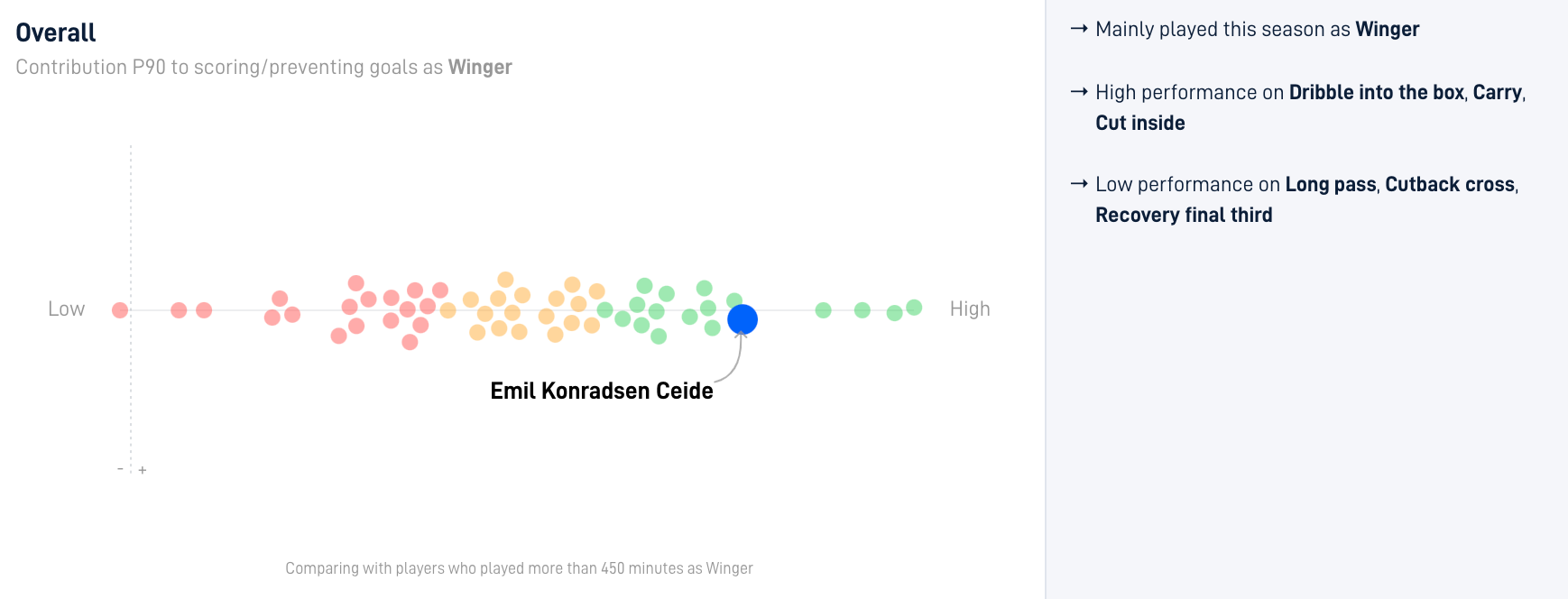 Figure 6. Emil Konradsen Ceide’s performance in the 2021 Eliteserien season. He was one of the highest contributors to his team compared to all wingers that played at least 450 minutes in the same season. He especially brings value to his team with his dribbles and offensive positioning.
Figure 6. Emil Konradsen Ceide’s performance in the 2021 Eliteserien season. He was one of the highest contributors to his team compared to all wingers that played at least 450 minutes in the same season. He especially brings value to his team with his dribbles and offensive positioning.
Other young players that show high performance are Kacper Kozlowski of Pogon Szczecin, Adis Jasic of Wolfsberger AC and Saymon Cabral of Spartak Trnava.
Best Paper Award
A scientific paper titled “Actions Speak Louder Than Goals: Valuing Player Actions in Soccer” that describes the technicalities of the ratings used in our Performance module was presented at the 25th ACM SIGKDD Conference on Knowledge Discovery and Data Mining in 2019 and won the Best Paper Award. The paper is available here.


